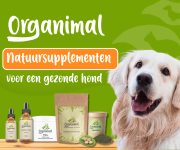You know you want to do it ... even if the Raw Nazis say no!
I'm talking about feeding vegetation:
10 Reasons To Feed Your Dog Vegetables And Fruit
You might not think fruits and vegetables for dogs would be controversial … but it is!
Many conventional veterinarians don’t believe they’re necessary for dogs – though some might tell you to add canned green beans to kibble if your dog needs to lose weight!
Some raw feeders also don’t give dogs vegetables, believing that an all-meat diet is sufficient to provide a full range of nutrients.
Others like to give their dogs a colorful array of veggies and fruits, and some experts like Dr Richard Pitcairn are now advocating vegetarian or vegan diets for dogs due to concerns about toxin levels in meats.
It seems everyone has a different opinion about veggies in a dog’s diet. So we turned to renowned Australian veterinarian Dr Ian Billinghurst for the answer.
Why Dr Billinghurst?
Dr Billinghurst wrote the groundbreaking book Give Your Dog A Bone in 1993 and Grow Your Pups With Bones in 1998.
He’s famous for creating the concept of BARF (Bones and Raw Food or Biologically Appropriate Raw (or Real) Food), and in 2001 he released his third book The BARF Diet.
We couldn’t think of a better canine nutrition expert to clarify this question. At the 2015 Raw Roundup Conference, Dr Billinghurst gave a talk on the role of vegetables and fruit in the healthy canine diet.
Dr Billinghurst highly recommends giving vegetables and fruits to your dog. In the course of his talk, he discussed 10 great reasons to feed your dog veggies and fruit.
(Note: Healthy foods nourish your dog from the inside out and give her immune system what it needs to stay strong. Click here to find out how to keep your dog’s gut healthy.)
#1 Evolution – Dogs Eat Vegetables Naturally
Check out where dogs are on the herbivore-carnivore continuum. They’re not obligate or pure carnivores and they’re definitely not pure herbivores … they’re midway between omnivores and carnivores.

Dogs, wolves and dingoes have eaten vegetables for hundreds of years.
Wild canines eat the gut contents of their prey
They scavenge fruit and other vegetable material
Dogs scavenge at garbage dumps
Modern dogs eat household scraps and may even dine at your compost heap!
#2 Vegetables Help Alkalize The Body
Balancing the alkalinity and acidity of the diet is important to your dog’s health.
Organs like the liver, pancreas, gallbladder, hormones, heart, kidneys function better in a more alkaline environment. Too much acidity can contribute to inflammation which is responsible for a lot of chronic diseases.
Proteins like meat make the body more acidic, while most vegetables and some fruits have an alkalinizing effect on the body.

#3 Range of Nutrients
Vegetables provide proteins, lipids, fats, carbohydrates, phytonutrients and fiber, making them a complete food – at least for herbivores like cows, sheep and rabbits. .
But it doesn’t mean your dog can thrive as a vegetarian. Dr Billinghurst doesn’t recommend a vegetarian diet for your dog.
First, it would be difficult to feed enough vegetables to fully nourish him.
Second, you’d need to add some grains and legumes to provide a proper balance of amino acids.
But grains and legumes are high in carbohydrates, which can aggravate a number of disease conditions. Protein sources like meat and muscle meats provide a full arrray of amino acids.

#4 Water
Fruit and veggies are an excellent source of water. Many dogs today live in a chronic state of dehydration, which contributes to problems such as kidney disease or the formation of bladder stones.
#5 Vitamins
Raw vegetables provide most vitamins, including:
Most of the B vitamins (but are low in B12, B1 (Thiamine) or Choline, so your dog needs foods like liver and eggs to supply these nutrients)
Vitamin C and co-factors: dogs make their own vitamin C but need the co-factors that help the body use it
Vitamin A, E and K
There’s not much vitamin D in vegetables and dogs don’t have enough bare skin to absorb it from the sun like we humans do. So again, dogs need liver to supply vitamin D.
#6 Minerals
Dark leafy green vegetables contain important minerals like calcium, potassium and magnesium.
Vegetables like alfalfa and seaweed are also good sources of minerals. Alfalfa roots go 40 feet down into the subsoil and absorb minerals from the earth. Seaweed picks up minerals and micronutrients that are washed into the sea.
Make sure these foods are organic, not produced with synthetic fertilizers. In the US alfalfa is a major genetically modified (GMO) crop so it’s even more important to find a certified organic source.
#7 Omega-3
Grasses and algae (phytoplankton) have a full complement of essential fatty acids and are rich in Omega-3 (even more so if they’re grown in a cold climate).
Omega-3 reduces inflammation and supports the brain and central nervous system, as well as breathing, circulation, digestion, immunity and reproduction.
When dogs are too high in Omega-6, it can impair these functions, so balancing the diet with Omega-3s is important.
While many people feed fish oils, they are very unstable and can turn rancid easily, so feeding plant based Omega-3s like phytoplankton is a good way to give your dog these essential fatty acids. Omega-3 helps slow degeneration and aging.
#8 Phytonutrients
Phytonutrients are only in vegetable material.
Phytonutrients are protective. They include enzymes, antioxidants and anti-inflammatory molecules (read more about these below).
Phytonutrients are antiviral, antifungal, antibacterial, antihelminthic (anti-worms), anti-aging, anti-degeneration and, most importantly, anti-cancer.
And yet most kibble-fed dogs get none of these nutrients!
Enzymes
Enzymes in food help digestion. Tropical fruits like pineapple (containing bromelain) and papaya (papain) are especially beneficial.
Some enzymes escape the hydrochloric acid in the stomach and are absorbed whole. When this happens they’re also anti-aging, anti-degeneration and pro-health in your dog’s body!
Antioxidants
Vegetables, fruits and herbs are chock full of antioxidants.
Antioxidants protect against free radicals (unstable molecules that are a major cause of aging) and again, you can only get them from fruits and vegetables.
Anti-Inflammatory Molecules
Anti-inflammatory molecules include herbs like turmeric, all kinds of berries, and Omega-3 fatty acids.
Omega-3 isn’t anti-inflammatory on its own, but it drives the anti-inflammatory effects of Omega-6, which is why dogs need both.
#9 Fiber
Raw vegetables supply healthy fiber.
Vegetable fiber is far better and much healthier than fiber from grains. Vegetables contain soluble fiber, which is digested by microbes in the large bowel. Insoluble fiber bulks out the food and helps it pass through the colon.
Fiber is vital in older dogs in treating and preventing degenerative disease.
#10 Vegetables Help Treat Disease
Most important of all, Dr Billinghurst has found that vegetables help treat all degenerative disease processes. He says vegetables are especially important in treating serious diseases like cancer and kidney disease.

How To Feed Vegetables
Dr Billinghurst recommends feeding vegetables to your dog, starting with puppies at about six weeks old.
Feed vegetables as about 10% of your dog’s diet. For therapeutic reasons in treating illness, Dr Billinghurst might prescribe vegetable content in the diet can be as high as 50%.
Feed Them Raw And Pulverized
Dr Billinghurst says vegetables must be fed raw for maximum benefits, but you’ll need to crush or pulverize them in a juicer or blender, or your dog won’t be able to digest them. Chopping or grating isn’t enough to make them digestible.
Use whatever vegetables are in season, feeding lots of variety. Avoid onions, legumes, macadamias and avocados, which can be toxic to dogs.
In case you’re wondering about garlic, it’s safe when used in moderation and has many health benefits … here’s more information on garlic.
Don’t overfeed vegetables in the cabbage family because they can depress the thyroid. It’s also best to avoid starchy vegetables like potatoes and sweet potatoes, and legumes like peas.
Potato skins contain a lot of nutrients and you can feed those pulverized. Just make sure the skins aren’t green because that makes them toxic.

Fruit must be fed ripe or it can cause diarrhea. Be careful about stones in fruit like plums as they can cause blockages. Don’t overfeed fruit to diabetic dogs or if your dog is very inflamed.
Dr Billinghurst recommends incorporating veggies and fruit into your dog’s raw diet by mixing them with ground raw meaty bones. Here are some other food choices he suggests adding as well.

If your dog isn’t on a raw diet, he can still benefit from getting the extra nutrients from some fresh whole foods.
In summary, Dr Billinghurst says that it’s not absolutely essential to feed dogs fruit and veggies, but there are many life stages and health states where feeding vegetable material can have major advantages.
(Download our Free Leaky Gut Workbook and get 3 simple steps to restore your dog’s health.).
Bron: https://www.dogsnaturallymagazine.com/1 ... tent=43550





